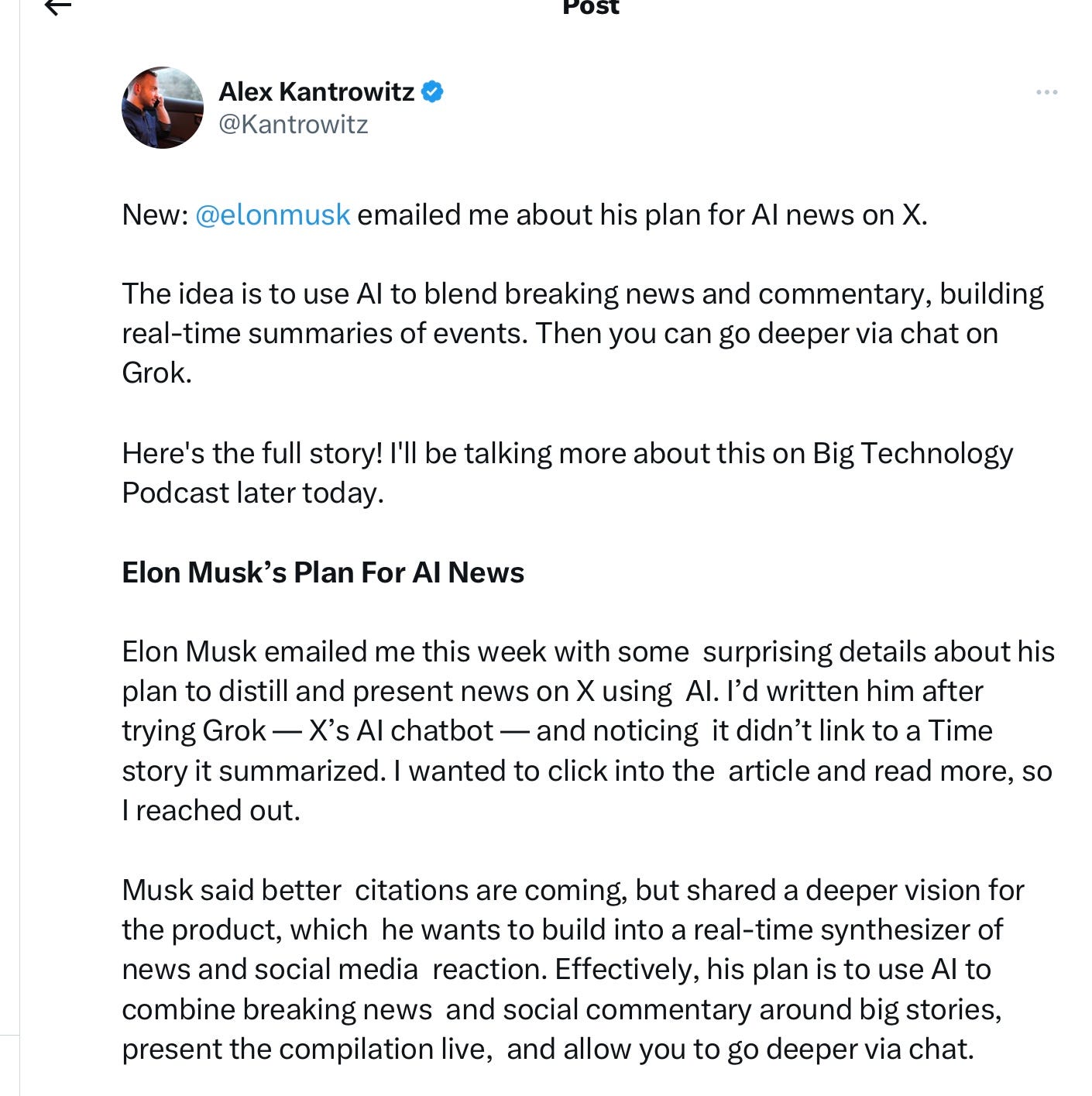Imagine a world where artificial intelligence can see and understand the world just like you do. It’s not science fiction anymore, thanks to Elon Musk’s latest innovation.
Meet the AI that’s got a keen eye for visuals, ready to transform how you interact with technology every day. This isn’t just another tech upgrade; it’s a leap forward that could redefine everything from your daily commute to how you enjoy entertainment.
Curious to find out how this game-changing technology works and what it means for your future? Stick around, because what you’re about to discover might just change your perspective on the world around you.
Also Read
- Genie 3: Unlocking Next-Level Automation Magic
- Best Ecommerce Platforms: Top Choices for Your Online Store
- How to Choose the Best Digital Product for Your Needs

Credit: felloai.com
Elon Musk’s Vision For Ai
Elon Musk’s vision for AI emphasizes transparency and safety. His latest AI advancement focuses on visual capabilities, enhancing understanding and interaction. This development promises improved AI applications in everyday life.
Elon Musk’s Vision for AI Elon Musk has always been a name synonymous with innovation and futuristic ideas. His vision for AI is no different. He aims to harness the power of AI to not only advance technology but to also ensure it benefits humanity as a whole. Imagine a world where AI drives your car and improves your daily life without posing threats. That’s Musk’s dream, and he’s making strides to turn it into reality.History And Evolution
Elon Musk’s journey with AI began with his concerns about its potential risks. He famously invested in AI research to keep an eye on its development and ensure it aligns with human interests. With ventures like OpenAI, Musk has been instrumental in steering AI toward safer and more ethical paths. His focus has been on creating AI that complements human intelligence rather than replacing it. His efforts reflect a desire to mitigate the fears many have about AI’s rapid growth. Musk’s initiatives show how AI can evolve responsibly. It’s fascinating to see someone so deeply invested in tech also prioritize ethical considerations.Impact On Technology
The impact of Musk’s AI vision on technology is already evident. Consider Tesla’s self-driving cars, which employ AI to enhance safety and convenience. This is not just futuristic; it’s happening now. His focus on AI has spurred advancements in numerous fields, from automation to space exploration. By prioritizing AI, Musk is pushing technology to new heights, creating products that we once thought only existed in science fiction. What does this mean for you? It means more efficient technologies that improve everyday life. But it also raises questions about our reliance on AI. Are we ready for such a future, and how will it redefine our interaction with technology? Musk’s work challenges us to think critically about these possibilities.
Credit: www.instagram.com
The Role Of Visual Ai
Visual AI is reshaping the way we interact with technology. It’s not just about interpreting images; it’s about understanding them like humans do. Think of the possibilities when machines can visually comprehend their surroundings. This technology is set to transform industries, from healthcare to automotive, with a level of precision previously unimaginable. Let’s dive into how Visual AI is enhancing machine learning and its applications across various sectors.
Enhancing Machine Learning
Visual AI is supercharging machine learning by adding a layer of image recognition. Imagine a machine learning model that doesn’t just process data but sees it. This ability allows systems to learn more efficiently and make accurate predictions.
Take your smartphone’s face recognition feature. It’s a perfect example of machine learning powered by Visual AI. It learns from your facial features, improving its accuracy over time. How many times have you marveled at how quickly your phone unlocks by just looking at it?
Visual AI also assists in filtering vast amounts of data. It helps machines identify patterns in images, enhancing their learning capabilities. As a result, these systems can perform tasks with minimal human intervention.
Applications In Industries
Visual AI is making waves across various industries. In healthcare, it’s used to analyze medical images, helping doctors diagnose diseases more quickly. This technology can even predict the onset of certain conditions. Have you ever considered how many lives could be saved with faster diagnosis?
In the automotive industry, Visual AI powers self-driving cars. These vehicles use cameras and sensors to understand the road, ensuring safety and efficiency. Imagine the convenience of commuting while your car handles the driving.
Retailers are using Visual AI to enhance the shopping experience. Systems analyze customer behavior, optimizing product placement and inventory management. Next time you visit a store, notice how products are strategically placed to catch your eye.
Visual AI is also making strides in agriculture. Drones equipped with this technology monitor crop health, optimizing yield and reducing waste. Could this be the key to solving food shortages?
As Visual AI continues to evolve, its applications seem limitless. How do you think it will impact your industry or daily life? The possibilities are endless, and the future is bright with Visual AI leading the way.
Technological Innovations
Elon Musk is known for pushing the boundaries of technology. Recently, his AI developments have taken a giant leap with visual capabilities. Imagine AI systems not just processing data but also interpreting images as humans do. This shift brings a host of innovations that promise to change how we interact with machines.
Advancements In Neural Networks
The core of these visual AI systems lies in neural networks. Think of them as the brain behind AI’s ability to “see.” Neural networks have evolved, enabling machines to recognize patterns and objects with astonishing accuracy. This isn’t just theory; it’s happening now. AI can now identify a cat or a car in a photo just like you can. Such advancements make AI more intuitive and responsive, bridging the gap between human and machine understanding.
Have you ever wondered how these networks learn? They mimic the human brain, processing information through layers. Each layer refines the data until a clear picture emerges. It’s like peeling an onion, layer by layer, revealing insights that were previously hidden. This process allows AI to learn and adapt, making it smarter over time.
Integration With Robotics
Visual AI isn’t just for analyzing images. It’s paving the way for smarter robots. Integrating these visual systems with robotics means machines can navigate the world with precision. Imagine a robot that can see and avoid obstacles, or even assist in surgeries with unparalleled accuracy. This isn’t science fiction. It’s the reality unfolding right before us.
Consider the possibilities in your own life. Would you trust a robot to make your coffee or clean your home? With visual AI, these tasks become not only possible but efficient and reliable. Robotics is moving beyond pre-programmed tasks to dynamic, visual decision-making. This innovation invites you to rethink what automation can achieve.
Such integration challenges us to explore new boundaries. It raises questions about the balance between machines and humans. Are we ready to embrace a world where robots understand and react visually just as we do? It’s a fascinating time to be a part of this technological evolution.
As you ponder these advancements, think about the future. How will visual AI reshape your daily interactions with technology? The possibilities are endless, and the journey has just begun.
Challenges And Ethical Considerations
Elon Musk’s AI innovations are transforming technology. Yet, these advancements come with challenges and ethical considerations. The visual AI systems raise important questions about privacy, bias, and fairness. Understanding these concerns is crucial for responsible AI development.
Privacy Concerns
AI systems process vast amounts of personal data. This raises significant privacy concerns. Users often share sensitive information unknowingly. AI’s ability to analyze and store data can lead to misuse. Unauthorized access to personal data poses risks. Protecting privacy is a major challenge.
Bias And Fairness
AI models learn from existing data. This data might have biases. If unchecked, AI systems can perpetuate these biases. Bias affects decision-making and can lead to unfair outcomes. Ensuring fairness in AI requires careful data selection. Developers must actively address these issues.
Future Prospects
Elon Musk’s AI has taken a significant step forward with visual capabilities. This leap opens a world of opportunities. The possibilities for AI applications are now vast. Future prospects appear promising and transformative. Let’s explore these exciting developments.
Potential For Growth
The introduction of visual AI could expand technology sectors. Industries like healthcare and automotive stand to benefit. AI can improve diagnostics and enhance vehicle safety. This growth can lead to new job opportunities. Companies might invest more in AI research and development. Startups could emerge, focusing on innovative AI solutions. Visual AI has the potential to become a major industry player.
Impact On Society
Visual AI could change daily life in many ways. It might improve accessibility for people with disabilities. AI could assist in tasks like reading and navigation. In education, AI could personalize learning experiences. This technology might even aid in security and surveillance. However, ethical concerns and privacy issues may arise. Society will need to address these challenges thoughtfully. Balancing innovation and privacy will be crucial.

Credit: garymarcus.substack.com
Frequently Asked Questions
What Is Elon Musk’s New Ai Technology?
Elon Musk’s new AI technology is a revolutionary advancement in visual AI. It combines cutting-edge algorithms with advanced visual processing capabilities. This AI aims to enhance computer vision, enabling machines to understand and interpret visual data more effectively.
How Does Elon Musk’s Ai Improve Visual Recognition?
Elon Musk’s AI improves visual recognition by using advanced deep learning techniques. It processes complex visual data with high accuracy and speed. This technology enhances the ability of machines to recognize and interpret images and videos more efficiently.
Why Is Visual Ai Important For Future Technology?
Visual AI is crucial for future technology because it enables machines to understand visual data. It supports advancements in autonomous vehicles, healthcare imaging, and smart surveillance. Enhanced visual AI can significantly improve decision-making and automation in various industries.
What Industries Benefit Most From Visual Ai?
Industries like automotive, healthcare, and security benefit most from visual AI. In automotive, it aids in developing autonomous vehicles. In healthcare, it enhances diagnostic imaging. Security industries use it for improved surveillance and threat detection.
Conclusion
Elon Musk’s latest AI development is truly fascinating. Visual capabilities in AI can change many industries. From healthcare to automotive, the impact is wide. Better image recognition means smarter technology. It helps machines understand the world like humans. This advancement could lead to safer roads and improved medical diagnostics.
As AI continues to grow, society will see more benefits. Staying informed about these changes is crucial. Embrace the future and watch AI evolve further. Keep an eye on Musk’s work, as it often leads to exciting innovations. AI’s visual future seems bright and promising.







